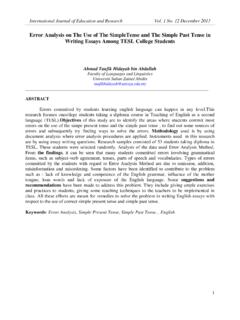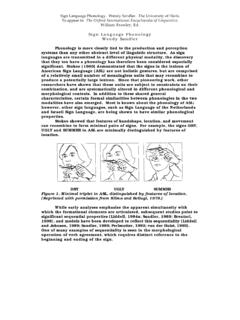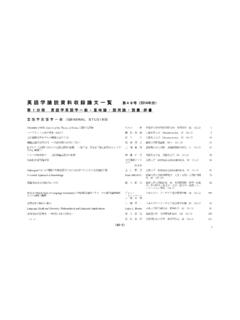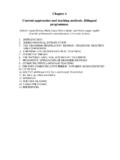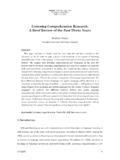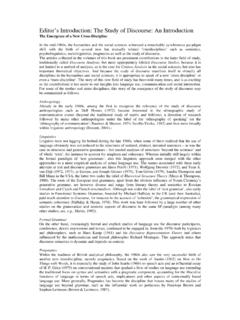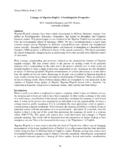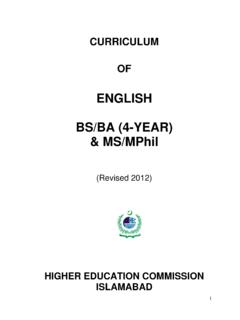Transcription of Politeness, Face and Facework: Current Issues
1 A Man of Measure Festschrift in Honour of Fred Karlsson, pp. 322 332 Liisa Vilkki politeness , face and facework : Current Issues Abstract The main purpose of this paper is to consider some Current Issues in the study of linguistic politeness and its relation to the notions of face and facework . These notions have received a myriad of different definitions in pragmatics and sociolinguistics during the last decades. On the basis of the examination of some definitions, it is concluded that the notions of politeness and face should not be equated. In addition, it is stated that the commonsense and the theoretical notions of politeness should be distinguished.
2 The paper also briefly discusses the relationship between epistemic meanings and meanings, related to facework . 1. Introduction Over the last three decades, face , facework and politeness have been among the most heavily debated notions in pragmatic and sociolinguistic research. Different kinds of theoretical models concerning these notions have been proposed, and usually they have been defined as abstract terms, directly or indirectly referring to a wide variety of social strategies for constructing co-operative social interaction across cultures. Cross-cultural work and empirical work in wide range of specific languages and cultures have, however, highlighted the socio-cultural variations in the interpretation of these kinds of terms.
3 In recent years, arguments have been presented for the importance of making a clearer distinction between theoretical and commonsense terms in politeness research. This paper first reviews some Current research into linguistic politeness and its relations to the notions of face and facework . Both the theoretical and lay interpretations are discussed. Secondly, the relationship between epistemic modality and facework is briefly considered. This constitutes an area which has up till now been scarcely examined from the cross-linguistic perspective. It is proposed that in the interpretation of the relationship between epistemic meanings and meanings, connected with politeness , face and facework 323facework, the notion of power is an essential one.
4 The implications of this proposal for the meaning description of epistemic expressions in different kinds of languages are also briefly considered. 2. The notions of politeness and face as theoretical and as commonsense terms A large number of theoretical and empirical books and articles concerning linguistic politeness and/or the notion of face have been published in the last decades. In most of the studies, the politeness has been conceptualized especially as strategic conflict-avoidance or as strategic construction of co-operative social interaction (cf. Eelen 2001: 21, Watts 2003: 47). The bibliography of politeness -related publications, compiled by Dufon & al.
5 (1994), comprises 51 pages in small print, and a great amount of new research has been amassed since its publication. It is beyond the limits of this paper to give an exhaustive overview of politeness -related research. Recently, some critical and thorough overviews and analyses of politeness studies have been presented, for example Eelen (2001), Watts (2003) and Bargiela-Chiappini (2003). Much earlier, Fraser (1990) posited four main ways of viewing politeness in the research literature: the social-norm view, the conversational-maxim view, the face-saving view and the conversational-contract view.
6 Eelen (2001), too, considers these views, but he uses partly different kinds of notions in comparing them and, in addition, he includes some other theoretical perspectives in his classification of politeness research. According to him, not only the notion of politeness as strategic conflict-avoidance, but also the notion of politeness as social indexing is universal to some extent in various frameworks of politeness (id., 20 29). These two notions originate in Kasper (1990). The idea that politeness should be understood as strategic conflict-avoidance can be found, for example, in the view that the basic social role of politeness is in its ability to function as a way of controlling potential aggression between interactional parties (Brown & Levinson 1987:1), or in the views that connect politeness with smooth communication (Ide 1989:225, 230) or with avoiding disruption and maintaining the social equilibrium and friendly relations (Leech 1983:17, 82).
7 The idea that politeness is involved in social indexing may be interpreted as the idea that politeness is socially appropriate behavior and what is socially appropriate depends on the speaker s social position in LIISA VILKKI 324 relation to the hearer. This idea, too, appears in some form or other in most works on politeness . Rather than presenting various other possible ways of comparing frameworks of politeness on the basis of, for example, Eelen s (2001) detailed analysis, I will now focus on briefly considering Brown & Levinson s (1978, 1987) theory of politeness and work criticizing some fundamental assumptions of this theory.
8 It has been the most influential framework of politeness so far, and it provides an important basis for the discussion of the notions of politeness and face in this paper. In the classification of Fraser (1990), Brown & Levinson s theory represents the face-saving view, as it builds on Goffman s (1967) notion of face and on English folk term, which ties face up with notions of being embarrassed or humiliated, or losing face . The face is understood as something that is emotionally invested, and that can be not only lost, but also maintained or enhanced. Brown & Levinson state that every individual has two types of face, positive and negative.
9 They define positive face as the individual s desire that her/his wants be appreciated in social interaction, and negative face as the individual s desire for freedom of action and freedom from imposition. The theory assumes that most speech acts, for example requests, offers and compliments, inherently threaten either the hearer s or the speaker s face-wants, and that politeness is involved in redressing those face threatening acts (FTA). On the basis of these assumptions, three main strategies for performing speech acts are distinguished: positive politeness , negative politeness and off-record politeness .
10 Positive politeness aims at supporting or enhancing the addressee s positive face, whereas negative politeness aims at softening the encroachment on the addressee s freedom of action or freedom from imposition. The third strategy, off-record politeness , means flouting one of the Gricean (1975) maxims on the assumption that the addressee is able to infer the intended meaning. On a more general level, Gricean model of Cooperative Principle is another building block in Brown & Levinson s theory. The kind and amount of politeness that the speaker applies to a certain speech act is determined by the weightiness of this speech act.

